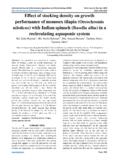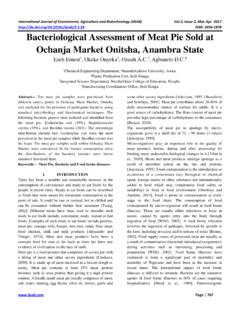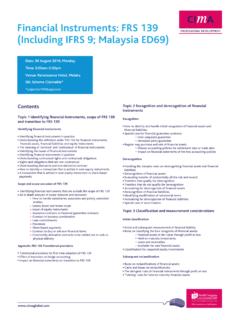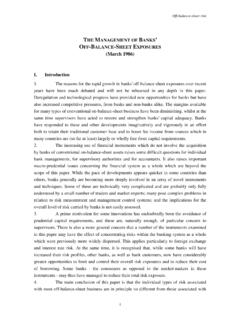Transcription of International Journal of Environment, Agriculture …
1 International Journal of Environment, Agriculture and Biotechnology (IJEAB) Vol-2, Issue-2, Mar-Apr- 2017. ISSN: 2456-1878. Environmental Changes and Effects on a Population of Smooth Newt Lissotriton meridionalis (Boulenger, 1882) (Amphibia, Urodela) in a Mediterranean Woodland Antonio Pizzuti Piccoli 1. Associazione Natura per Tutti Onlus Via Monteroni n 1265, 00055 Ladispoli (RM) Italy. Abstract The population of Lissotriton meridionalis in development (BELL & LAWTON, 1975; ACCORDI &. the area of Bosco di Palo Natural Park are monitored NOBILI, 1999; PIZZUTI PICCOLI, 2008). since 1995. From 2004 to 2005 in the area it was carried The smooth newt breeds in both temporary and perennial out a massive cutting of dead trees with evidence of waters (ponds, lakes, fountains), never in the flowing alteration of the undergrowth. The study aims to verify, waters (BELL, 1977; RAZZETTI & BERNINI, 2006). Given through the index of the population estimate, if the the absence of fish, temporary ponds have the advantage species has suffered changes in the size of the population of significantly reducing the number of predators present.
2 Following environmental changes. For the research were The temporary ponds, on the other hand, are extremely chosen three ponds in the wood and the data collection unpredictable habitats and often a premature drying can took place from the breeding season of 1995 1996 to destroy a whole generation of larvae. 2014 2015, in each of the seasons was made an Metamorphosed individuals spend about two years in the estimation of the population density. The data obtained undergrowth before reaching sexual maturity and return are been compared in order to make assessments on the for reproduction in the ponds. The adults make terrestrial conservation status and persistence of the species in the life outside of the breeding season (GRIFFITHS, 1984;. site, also as a result of environmental changes suffered by AGREEMENTS et al., 1990). Bosco di Palo Natural Park. The analysis of the Actually their habits in the terrestrial phase are still little population estimate, used in this work as an index of the known; in particular smooth newts seem to use habitats conservation status of the species in the Park, confirms characterized by old tall forests with undergrowth.
3 That, in the previous period and in the period following The individuals mostly remain in the vicinity of area of the die-off of trees and cutting plant health, we have deposition (50% within 100 meters, 100% within 700. substantially the same values of population size. meters), though they are rarely found, during terrestrial Keywords Biscogniauxia mediterranea, Lissotriton phase, at less than 30 meters from the ponds meridionalis, Bosco di Palo Natural Park, population (RITTENHOUSE & SEMLITSCH, 2007; SEMLITSCH, 2008). estimate, temporary pond, terrestrial phase, wood In the Bosco di Palo Natural Park, populations of cutting. Lissotriton meridionalis are monitored since 1995 and we have seen how their status and their reproductive biology I. INTRODUCTION are closely correlated with rainfall, temperatures and The present work aims to contribute to know the seasonal filling of temporary ponds (PIZZUTI PICCOLI, dynamics of the population of Smooth Newt Lissotriton 2008; PIZZUTI PICCOLI, 2010).
4 Meridionalis (Boulenger, 1882) as a result of Since the 90s, the water table of Bosco di Palo has environmental alteration due to human activities. suffered a significant decrease, as underlined by the The Smooth Newt Lissotriton meridionalis (Boulenger, irregularity of filling of the temporary ponds present. 1882) is an Amphibian distributed in the Italian Because of the soil drying and the consequent state of peninsula, with the exclusion of the southern regions water stress of the trees, since 1999, the mushrooms (RAZZETTI & BERNINI, 2006). Its ecology, in the Phytophtora sp. and Biscogniauxia mediterranea (De Mediterranean, is closely influenced by local Not.) O. Kuntze have given rise to an epidemic that lead environmental parameters. The vitality of the populations to the death of a high percentage of the trees of the forest is closely linked to the conservation of small wetland, (FRATICELLI, 2003; PETRICCIONE, 2003; SCARNATI &. often temporary, that allow egg laying and larval ATTORRE, 2014; SOLOMOU et.)
5 Al., 2017). Page | 584. International Journal of Environment, Agriculture and Biotechnology (IJEAB) Vol-2, Issue-2, Mar-Apr- 2017. ISSN: 2456-1878. The pathogen has spread through the vessels of wooden formed by coastal dune and beach (currently in strong fibers cavity, large and empty due to the lack of water so erosion). The soil wooded area is characterized by clay. as to colonize the woody tissues, killing the tree in a The climate is part of the type mesomediterranean with single growing season. mild winter, a summer period of about three months of Consequently, in 2004 and then in 2005 it was carried out dryness and rainfall regime of maritime type. a massive cutting of trees in order to eliminate the fungal The environments that we find in the Park are the pathogens. The cut and the removal of the timber was Mediterranean scrub, planitial wood and grassland. The operated mechanically (with the use of a bulldozer), with planitial wood, characterized by the presence of evidence of alteration of the undergrowth.
6 Temporary ponds, consists of a mixed forest of deciduous The cut has produced the creation of a large clearing in oaks of about 60 hectares, with the dominance of Quercus the middle of the forest, characterized by the presence of ilex L., Quercus cerris L., Quercus pubescens Willd. and scattered trees and a uniform layer of sclerophyllous Ulmus minor Miller (LUCCHESE 1990). The amphibians shrubs. The average percentage of coverage of the tree of the study area are represented by four species: Bufo layer, considering the coverage of the upper layer to 8 bufo (Linnaeus, 1758), Hyla intermedia Boulenger, 1882, meters in height, is lower (42%) compared with the Pelophylax bergeri (G nther, 1986) / Pelophylax klepton computed values for the same site in 1983 (75%) hispanicus (Bonaparte, 1839) and Lissotriton (FRATICELLI & SARROCCO, 2012) meridionalis (Boulenger, 1882). Habitat alteration is now considered one of the possible The temporary ponds are temporary water basins whose causes of the decline of amphibian populations in Italy depth varies between 20 and 150 cm.
7 These environments and Europe (D'AMEN & BOMBI, 2009). are extremely precarious because they are influenced by The study aims to verify, through the index of the the seasonal weather patterns. Because of the shallow, population estimate, if the Lissotriton meridionalis, given thermal stratification is absent; the temperature of the the importance of the terrestrial habitat during the non water, from surface to bottom, is under the direct reproductive phase of adults and in the period of growth influence of the sun and reflects the seasonal and daily of metamorphosed individuals, has suffered changes in variations in air temperature, even if it remains always the size of the population following damage to vegetation. few degrees below respect to it. The ponds undergo a drying period, from June to September, and freezing at II. STUDY AREA the surface for few days during negative peaks of The Bosco di Palo Natural Park (Figure 1) is located 37 temperatures in the months of January and February.
8 The km to the north of Rome (Central Italy - IGM oxygen concentration is subject to daily and annual Topographic Map Sheet 149 NE IV) and is situated fluctuations and also varies vertically; it is higher in between the sea and the Via Aurelia in locality of Palo surface for the presence of photosynthetic organisms and Laziale, in the town of Ladispoli (41 56 'N, 12 05 'E). less abundant on the bottom for the presence of organisms The study area is part of a narrow coastal plain that decomposers. The water pH decreases with the onset of extends from the delta of the Tiber River and that was warm weather (GATTA, 1990; MURA & BRECCIAROLI, formed during the Quaternary period. 2003). The bottom of the ponds is characterized by a strong decomposing activity; the half-submerged trees growing around the ponds and directly into the water (mainly Fraxinus oxycarpa Bieb.) release a considerable mass of leaves on the bottom of ponds. Within the ponds, the vegetation is very scarce and characterized by terrestrial grasses that withstand periods of immersion.
9 After the phytosanitary cut the vegetation composition was altered. For the research were chosen three ponds in the wood that have the following characteristics: Pond 1, called "pond of Emys", with a maximum diameter of 20 m, a maximum Fig. 1: The Bosco di Palo Natural Park. area of sq. m. and a maximum depth of 120 cm;. Pond 2, called "pond of newts", with a maximum The territory was divided into three longitudinal strips diameter of 4 m, maximum area of sq. m. and a parallel to the sea, a band made up of silt deposits and maximum depth of 81 cm; Pond 3, called "pond of reeds", marshy black lands, an intermediate band characterized with a diameter of 22 m, maximum area of 69 sq. m. with by ancient fossil dunes and a third more recent band a maximum depth of 83 cm. The Pond 3 is characterized Page | 585. International Journal of Environment, Agriculture and Biotechnology (IJEAB) Vol-2, Issue-2, Mar-Apr- 2017. ISSN: 2456-1878. by the coverage of rushes, Juncus sp. and Typha sp. in Bailey's modification is thought to yield a better estimate about a third of the surface (LUCCHESE,1990).
10 When sample size is small (less than circa 20) (BAILEY, 1951; GREENWOOD & ROBINSON, 2006). III. MATERIAL AND METHODS The long term monitoring allows to compare the The data collection took place from the breeding season population estimate obtained during all the years of study of 1995 1996 until the breeding season 2014 - 2015, the in order to make assessments on the conservation status breeding season is considered the beginning of the filling and persistence of the species in the site, also as a result of temporary ponds until they are completely drained. of environmental changes suffered by Bosco di Palo . Samples were taken every fifteen days. The capture of the Natural Park. specimens was performed by dipnetting, according to pre- The field monitoring was conducted in accordance with established transects, by using a net square shape with applicable laws and authorizations provided for this kind side of 36 sq. cm, with square mesh of cm side. of studies. Handling of individuals was made in For each sampling has been established dipnetting mode compliance with the standards necessary to prevent according to the size of the pond (HEYER, 1988); in the transmission of pathogens between individuals (RAZZETTI.)





